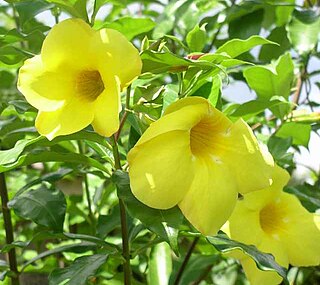
Allamanda cathartica, commonly called golden trumpet, common trumpetvine, and yellow allamanda, is a species of flowering plant of the genus Allamanda in the family Apocynaceae. It is native to Brazil. This plant is cited in Flora Brasiliensis by Carl Friedrich Philipp von Martius.

Ficus elastica, the rubber fig, rubber bush, rubber tree, rubber plant, or Indian rubber bush, Indian rubber tree, is a species of plant in the fig genus, native to eastern parts of South Asia and southeast Asia. It has become naturalized in Sri Lanka, the West Indies, and the US State of Florida.
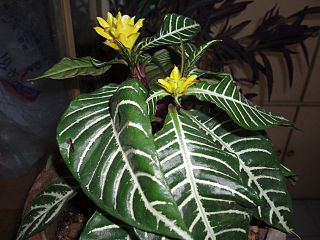
Aphelandra is a genus of about 170 species of flowering plants in the family Acanthaceae, native to tropical regions of the Americas.

August Wilhelm Eichler, also known under his Latinized name, Augustus Guilielmus Eichler, was a German botanist who developed a new system of classification of plants to reflect the concept of evolution. His author abbreviation in botany is Eichler.
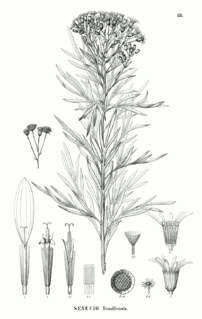
Flora Brasiliensis is a book published between 1840 and 1906 by the editors Carl Friedrich Philipp von Martius, August Wilhelm Eichler, Ignatz Urban and many others. It contains taxonomic treatments of 22,767 species, mostly Brazilian angiosperms.

Verbena brasiliensis, the Brazilian verbena or Brazilian vervain, is a flowering plant species from the vervain family (Verbenaceae). It is native to parts of South America, namely Brazil, but has spread its range in recent times and has occasionally become an invasive weed. It is an annual plant with purple flowers, and it has been introduced outside of its native range as an ornamental plant, and is now largely considered an invasive weed in these regions.
Ruellia verbasciformis is a plant native to the Cerrado vegetation of Brazil. This plant is cited in Flora Brasiliensis by Carl Friedrich Philipp von Martius.
Hygrophila costata, with the common names glush weed, gulf swampweed, and yerba de hicotea, is an aquatic plant
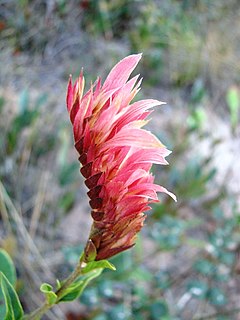
Lophostachys floribunda is a plant native to the Caatinga and Cerrado vegetation of Brazil. This plant is cited in Flora Brasiliensis by Carl Friedrich Philipp von Martius.
Justicia tocantina is a plant native to Argentine, and the Cerrado vegetation of Brazil. This plant is cited in Flora Brasiliensis by Carl Friedrich Philipp von Martius.
Stenandrium pohlii, with Portuguese common names caiapiá or carapiá, is a plant native to Cerrado and Pantanal vegetation of Brazil. The description of the plant was published in Flora Brasiliensis in 1847.
Stenandrium hirsutum is a plant native to the Cerrado vegetation of Brazil. The description of the plant was published in Flora Brasiliensis in 1847.
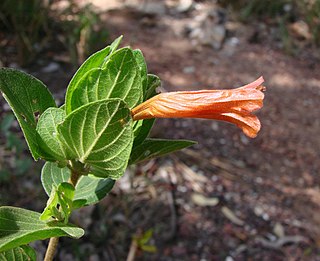
Ruellia villosa is a plant native to the Cerrado vegetation of Brazil. This plant is cited in Flora Brasiliensis by Carl Friedrich Philipp von Martius.

Aphelandra squarrosa is a plant species in the family Acanthaceae, which is native to Atlantic Forest vegetation of Brazil. This plant is often used as a house plant. This plant is cited in Flora Brasiliensis by Carl Friedrich Philipp von Martius.

Aspidosperma parvifolium is a timber tree native to Brazil, which is typical of Atlantic Forest, Cerrado, Caatinga, and Pantanal vegetation. This plant is cited in Flora Brasiliensis by Carl Friedrich Philipp von Martius. In addition, it is useful for beekeeping.

Aechmea gamosepala is a bromeliad endemic to southern Brazil. It is often cultivated as an ornamental plant. This plant is cited in Flora Brasiliensis by Carl Friedrich Philipp von Martius

Anemopaegma glaucum is a plant native to Caatinga and Cerrado vegetation in Brazil. This plant is cited in Flora Brasiliensis by Carl Friedrich Philipp von Martius.

Asteranthos is a genus of woody plant in the family Lecythidaceae. There is only one known species, Asteranthos brasiliensis, native to Venezuela and Brazil.

Ignatz Urban was a German botanist. He is known for his contributions to the flora of the Caribbean and Brazil, and for his work as curator of the Berlin Botanical Garden. Born the son of a brewer, Urban showed an interest in botany as an undergraduate. He pursued further study at the University of Bonn and later at the University of Berlin where he gained a doctorate in 1873. Urban was appointed by A. W. Eichler to run the Berlin Botanical Garden and supervised its move to Dahlem. He also worked as Eichler's assistant on the Flora Brasiliensis, later succeeding him as editor. In 1884 Urban began working with Leopold Krug on his Puerto Rican collections, a collaboration would later produce the nine-volume Symbolae Antillanae, one of his most important contributions, and his 30-part Sertum Antillanum. Urban's herbarium, estimated to include 80,000 or more sheets, was destroyed when the Berlin Herbarium was bombed in 1943, during the Second World War.
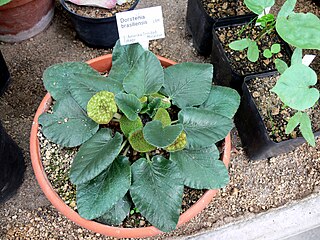
Dorstenia brasiliensis is a species of herbaceous plant in the family Moraceae of the order Rosales.












